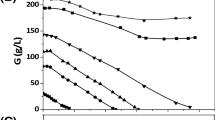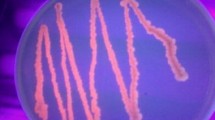Abstract
A newly isolated poly(3-hydroxybutyrate) [P(3HB)] producing strain, ST1C, was identified as Bacillus aryabhattai based on its morphological, biochemical and molecular characteristics. It synthesized and accumulated relatively high amounts of P(3HB). The aim of this work was to establish if it could convert an inexpensive liquid waste product from the production of biodiesel, biodiesel liquid waste (BLW), to P(3HB). Using a mineral salt medium (MSM) containing 2.0 % (v/v) glycerol present in the BLW and both normal batch and a draw and fill culture method, B. aryabhattai ST1C produced a maximum P(3HB) content and biomass concentration of 72.31 % dry cell weight (DCW) and 7.24 g/L, respectively, over a 24 h cultivation period in the draw and fill cultivation method. From 24 h to the end of cultivation at 72 h both the P(3HB) content and the biomass concentrations continuously reduced. Concentrations of glycerol in the BLW in this MSM above 3.0 % (v/v) or from pure glycerol (PG) or with an added NaCl concentration of greater than 3.0 % significantly reduced both the maximum P(3HB) content and the biomass concentrations.





Similar content being viewed by others
References
Ashby RD, Solaiman DKY, Foglia TAU (2004) Bacterial poly (hydroxyalkanoate) polymer production from the biodiesel co-product stream. J Polym Environ 12(3):105–112
Ashby RD, Solaiman DKY, Foglia TAU (2005) Synthesis of short-/mediumchain-length poly(hydroxyalkanoate blends by mixed culture fermentation of glycerol. Biomacromolecules 6(4):2106–2112
Bondioli P, Della Bella L (2005) An alternative spectrophotometric method for the determination of free glycerol in biodiesel. Eur J Lipid Sci Technol 107(3):153–157
Cavalheiro JMBT, Almeida MCMD, Grandfils C, Fonseca MMR (2009) Poly(3-hydroxybutyrate) production by Cupriavidus necator using waste glycerol. Process Biochem 44(5):509–515
Chaudhry WN, Jamil N, Ali I, Ayaz MH, Hasnain S (2011) Screening for polyhydroxyalkanoate (PHA)-producing bacterial strains and comparison of PHA production from various inexpensive carbon sources. Ann Microbiol 61(3):623–629
Chee JY, Yoga SS, Lau NS, Ling SC, Abed RMM, Sudesh K (2010) Bacterially produced Polyhydroxyalkanoate (PHA): converting renewable resources into bioplastics. In: Mendez-Vilas A (ed) Current research, technology and education topics in Applied Microbiology and Microbial Biotechnology, vol. 2. Formatex Research Center Publishers, Badajoz, pp 1395–1404
Din MFM, Ujang Z, Loosdrecht MV, Ahmad MA (2008) Polyhydroxyalkanoates (PHAs) production from saponified sunflower oil in mixed cultures under aerobic condition. J Technol 48:1–19
Hansen CF, Hernandez A, Mullan BP, Moore K, Trezona-Murray M, King RH, Pluske JR (2009) A chemical analysis of samples of crude glycerol from the production of biodiesel in Australia, and the effects of feeding crude glycerol to growing-finishing pigs on performance, plasma metabolites and meat quality at slaughter. Anim Prod Sci 49(2):154–161
Ibrahim MHA, Steinbüchel A (2009) Poly(3-Hydroxybutyrate) production from glycerol by Zobellella denitrificans MW1 via high-cell-density fed-batch fermentation and simplified solvent extraction. Appl Environ Microbiol 75(19):6222–6231
Kawata Y, Aiba S (2010) Poly (3-hydroxybutyrate) production by isolated Halomonas sp. KM-1 using waste glycerol. Biosci Biotechnol Biochem 74(1):175–177
Kimura M (1980) A simple method for estimating evolutionary rates of base substitutions through comparative studies of nucleotide sequences. J Mol Evol 16(2):111–120
Krueger CL, Radetski CM, Bendia AG, Oliveira IM, Castro-Silva MA, Rambo CR, Antonio RV, Lima AOS (2012) Bioconversion of cassava starch by-product into Bacillus and related bacteria polyhydroxyalkanoates. Electron J Biotechnol 15(3):1–13
Kulpreecha S, Boonruangthavorn A, Meksiriporn B, Thongchul N (2009) Inexpensive fed-batch cultivation for high poly (3-hydroxybutyrate) production by a new isolate of Bacillus megaterium. J Biosci Bioeng 107(3):240–245
Mengmeng C, Hong C, Qingliang Z, Shirley SN, Jie R (2009) Optimal production of polyhydroxyalkanoates (PHA) in activated sludge fed by volatile fatty acids (VFAs) generated from alkaline excess sludge fermentation. Bioresour Technol 100(3):1399–1405
Merugu R, Rudra MPP, Girisham S, Reddy SM (2012) PHB (Polyhydroxybutyrate) production under nitrogen limitation by Rhodobacter capsulatus KU002 isolated from tannery effluent isolated from tannery effluent. Int J Chem Tech Res 4(3):1099–1102
Mothes G, Schnorpfeil C, Ackermann JU (2007) Production of PHB from crude glycerol. Eng Life Sci 7(5):475–479
Obruca S, Marova I, Melusova S, Mravcova L (2011) Production of polyhydroxyalkanoates from cheese whey employing Bacillus megaterium CCM 2037. Ann Microbiol 61(4):947–953
Pandian SR, Deepak V, Kalishwaralal K, Rameshkumar N, Jeyaraj M, Gurunathan S (2010) Optimization and fed-batch production of PHB utilizing dairy waste and seawater as nutrient sources by Bacillus megaterium SRKP-3. Bioresour Technol 101(2):705–711
Sabra W, Abou-Zeid DM (2008) Improving feeding strategies for maximizing polyhydroxybutyrate yield by Bacillus megaterium. Res J Microbiol 3(5):308–318
Saitou N, Nei M (1987) The neighbor-joining method: a new method for reconstructing phylogenetic trees. Mol Biol Evol 4(4):406–425
Shivaji S, Chaturvedi P, Begum Z, Pindi PK, Manorama R, Padmanaban AD, Shouche YS, Pawar S, Vaishampayan P, Dutt CBS, Datta GN, Manchanda RK, Rao UR, Bhargava PM, Narlikar JV (2009) Janibacter hoylei sp. nov., Bacillus isronensis sp. nov., and Bacillus aryabhattai sp. nov., isolated from cryotubes used for collecting air from the upper atmosphere. Int J Syst Evol Microbiol 59(12):2977–2986
Shrivastav A, Mishra SK, Shethia B, Pancha I, Jain D, Mishra S (2010) Isolation of promising bacterial strains from soil and marine environment for polyhyhydroxyalkanoates (PHAs) production utilizing Jatropha biodiesel byproduct. Int J Biol Macromol 47(2):283–287
Silva GP, Mack M, Contiero J (2009) Glycerol: a promising and abundant carbon source for industrial microbiology. Biotechnol Adv 27(1):30–39
Sindhu R, Ammu B, Binod P, Deepthi SK, Ramachandran KB, Soccol CR, Pandey A (2011) Production and characterization of poly-3-hydroxybutyrate from crude glycerol by Bacillus sphaericus NII 0838 and improving its thermal properties by blending with other polymers. Braz Arch Biol Technol 54(4):783–794
Sudesh K, Abe H, Doi Y (2000) Synthesis, structure and properties of polyhydroxyalkanoates: biological polyesters. Prog Polym Sci 25(10):1503–1555
Sun Z, Ramsay JA, Martin G, Ramsay BA (2009) Fed-batch production of unsaturated medium-chain-length polyhydroxyalkanoates with controlled composition by Pseudomonas putida KT2440. Appl Microbiol Biotechnol 82(4):657–662
Tanamool V, Kaewkannetra P (2011) Direct screening of potential polyhydroxyalkanoates (PHAs) bacterial from soil environment using sweet sorghum as a sole carbon source. In: World Congress on Engineering and Technology; CET2011 (28th October, 2011, Tongji University and Wuhan University, Guangdong Hotel, Shanghai, China). 978(5):397–400
Teeka J, Imai T, Cheng X, Reungsang A, Higuchi T, Yamamoto K, Sekine M (2010) Screening of PHA-producing bacteria using biodiesel-derived waste glycerol as a sole carbon source. J Water Environ Technol 8(4):373–381
Thompson JC, He BB (2006) Characterization of crude glycerol from biodiesel production from multiple feedstocks. Appl Eng Agric 22(2):261–265
Volova TG, Boyandin AN, Vasiliev AD, Karpov VA, Prudnikova SV, Mishukova OV, Boyarskikh UA, Filipenko ML, Rudnev VP, Xuan BB, Dung VV, Gitelson II (2010) Biodegradation of polyhydroxyalkanoates (PHAs) in tropical coastal waters and identification of PHA-degrading bacteria. Polym Degrad Stab 95(12):2350–2359
Wattanaphon HT, Pisutpaisal N (2011) Production of polyhydroxyalkanoate biopolyester from glycerol using UASB seed culture. J Appl Sci 10(1):7–17
Yang F, Hanna MA, Sun R (2012) Value-added uses for crude glycerol–a byproduct of biodiesel production. Biotechnol Biofuels 5:13–23
Zakaria MR, Tabatabae IM, GhazalI FM, Aziz SA, Shirai Y, Hassan MA (2010) Polyhydroxyalkanoate production from anaerobically treated palm oil mill effluent by new bacterial strain Comamonas sp. EB172. World J Microbiol Biotechnol 26(5):767–774
Zhu C, Nomura CT, Perrotta JA, Stipanovic AJ, Nakas JP (2010) Production and characterization of Poly-3-hydroxybutyrate from Biodiesel-Glycerol by Burkholderia cepacia ATCC17759. Biotechnol Prog 26(2):424–430
Acknowledgments
We would like to acknowledge gratefully the Specialized R & D Center for Alternative Energy from Palm Oil and Oil Crops, Faculty of Engineering, Prince of Songkla University for the supply of their biodiesel liquid waste. This research was financially supported by Prince of Songkla University (SCI560117S) and the Development and Promotion of Science and Technology Talents Project (DPST) Scholarship, Thailand.
Author information
Authors and Affiliations
Corresponding author
Electronic supplementary material
Below is the link to the electronic supplementary material.
ESM 1
(DOCX 2.87 mb)
Rights and permissions
About this article
Cite this article
Chanasit, W., Sueree, L., Hodgson, B. et al. The production of poly(3-hydroxybutyrate) [P(3HB)] by a newly isolated Bacillus sp. ST1C using liquid waste from biodiesel production. Ann Microbiol 64, 1157–1166 (2014). https://doi.org/10.1007/s13213-013-0755-1
Received:
Accepted:
Published:
Issue Date:
DOI: https://doi.org/10.1007/s13213-013-0755-1




